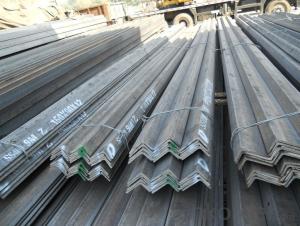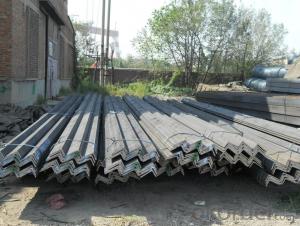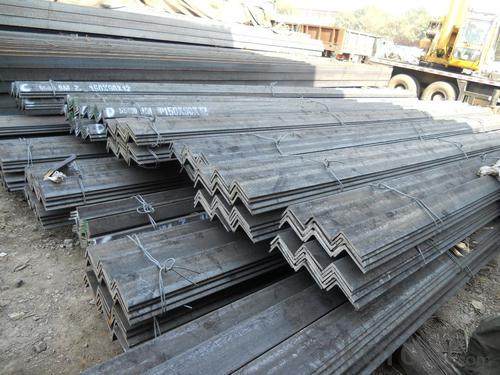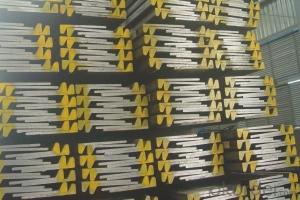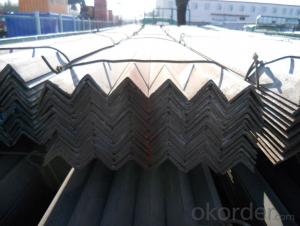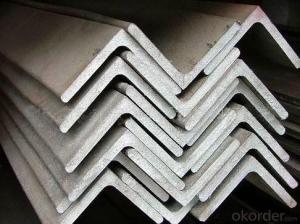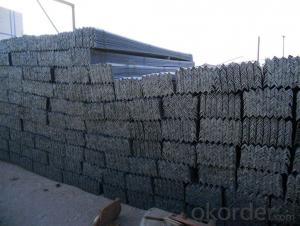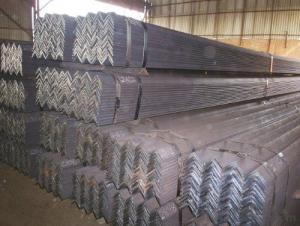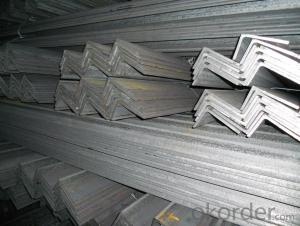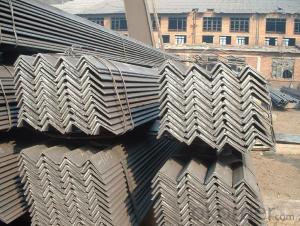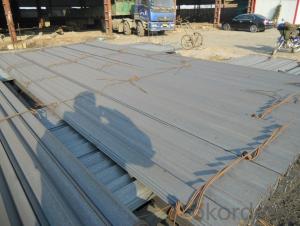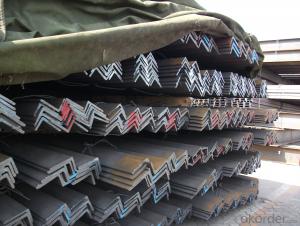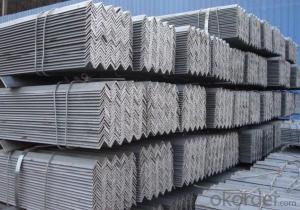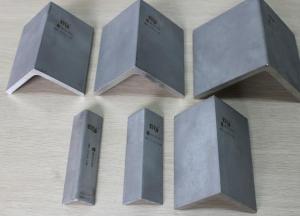High Quality Unequal Steel Angle
OKorder Service Pledge
OKorder Financial Service
You Might Also Like
Specifications of Unequal Steel Angle:
1.Standards: GB
2.Length: 6m,9m,12m
3.Material: Q235, Q345 or Equivalent
4. Size:
Size (mm) | Mass (mm) | Size (mm) | Mass (mm) |
| 150*75*9 | 15.4 | 150*90*9 | 16.5 |
| 150*75*10 | 17.0 | 150*90*10 | 18.2 |
| 150*75*12 | 20.2 |
Packaging & Delivery of Unequal Steel Angle:
1. Transportation: the goods are delivered by truck from mill to loading port, the maximum quantity can be loaded is around 40MTs by each truck. If the order quantity cannot reach the full truck loaded, the transportation cost per ton will be little higher than full load.
2. With bundles and load in 20 feet/40 feet container, or by bulk cargo, also we could do as customer's request.
3. Marks:
Color mark: There will be color marking on both end of the bundle for the cargo delivered by bulk vessel. That makes it easily to distinguish at the destination port.
Tag mark: There will be tag mark tied up on the bundles. The information usually including supplier logo and name, product name, made in China, shipping marks and other information request by the customer.
If loading by container the marking is not needed, but we will prepare it as customer request.
*If you would like to get our price, please inform us the size, standard/material and quantity. Thank you very much for your attention.
- Q: What are the guidelines for designing connections using steel angles?
- The guidelines for designing connections using steel angles typically involve determining the appropriate angle size, thickness, and length based on the loads and forces that will be applied to the connection. Additionally, considerations such as the type of welds or bolts to be used, the spacing and arrangement of the angles, and any applicable design codes or standards must be taken into account. It is important to ensure that the connection is structurally sound and provides adequate strength and stability for the intended application.
- Q: Can steel angles be used in transportation or infrastructure projects?
- Indeed, transportation or infrastructure projects can incorporate steel angles. Owing to their robustness and endurance, steel angles are frequently employed in construction. They are commonly utilized to furnish structural reinforcement and steadiness in a myriad of scenarios, including bridges, buildings, highways, and railways. In the realm of transportation projects, steel angles can be employed to fabricate vehicle ramps, guardrails, and frameworks for overhead signs. In infrastructure projects, they can be leveraged to erect retaining walls, foundations, and frameworks for utility installations. The adaptability and dependability of steel angles render them a favored option in these particular project types.
- Q: Can steel angles be used in the construction of sports stadiums?
- Yes, steel angles can be used in the construction of sports stadiums. Steel angles are versatile structural elements that can be used to support heavy loads and provide stability in large structures like sports stadiums. They are commonly used in the construction industry for various applications, including framing, support columns, and bracing systems. Steel angles offer excellent strength and durability, making them suitable for withstanding the dynamic forces and heavy loads experienced in sports stadiums. Additionally, steel angles can be easily fabricated and customized to fit the specific design and structural requirements of the stadium, offering flexibility in construction. Overall, steel angles are an ideal choice for the construction of sports stadiums due to their strength, versatility, and ability to withstand the unique demands of such large-scale structures.
- Q: Can steel angles be used in mezzanine or raised platform constructions?
- Yes, steel angles can be used in mezzanine or raised platform constructions. Steel angles are versatile structural elements that can provide support and stability in construction projects. They are commonly used as framing members in mezzanine or raised platform structures due to their strength and load-bearing capabilities. Steel angles can be easily connected to other steel components, such as beams and columns, to form a rigid framework for the mezzanine or raised platform. Additionally, steel angles can be used to create bracing and reinforcement elements, enhancing the overall stability and safety of the structure. Overall, steel angles are a popular choice for mezzanine or raised platform constructions due to their durability, versatility, and cost-effectiveness.
- Q: What are the different types of steel angles used in manufacturing industries?
- In manufacturing industries, there is a wide variety of steel angles utilized for different purposes. These angles possess unique characteristics that make them suitable for specific applications. 1. Unequal Leg Angles, also known as L-shaped angles, feature one longer leg and one shorter leg. They find common usage in construction and structural engineering due to their versatility. These angles offer exceptional strength and stability, making them ideal for supporting heavy loads and establishing structural connections. 2. Equal Leg Angles, also known as L-shaped angles, have both legs of equal length. They are extensively employed in manufacturing industries for diverse purposes, including bracing, framing, and supporting structures. These angles exhibit good resistance to bending and provide stable connections in various applications. 3. Stainless Steel Angles are crafted from a corrosion-resistant steel alloy, primarily comprising chromium. They possess remarkable durability, resistance to rust, and excellent strength properties. Stainless steel angles find widespread use in industries such as food processing, chemical processing, and marine manufacturing, where corrosion resistance is of utmost importance. 4. Galvanized Steel Angles are coated with a layer of zinc to safeguard them against corrosion and rust. This zinc coating ensures exceptional durability and longevity, rendering galvanized steel angles suitable for outdoor and exposed applications. They are commonly employed in industries like construction, agriculture, and transportation. 5. Rolled Steel Angles are manufactured by rolling a steel plate or sheet into the desired shape. These angles offer an excellent strength-to-weight ratio and can be produced in varied sizes and thicknesses. Rolled steel angles find extensive usage in construction, machinery, and fabrication industries for structural support and framing applications. 6. Slotted Steel Angles possess holes or slots along their length, allowing for flexibility in terms of fastening methods. They are frequently employed in shelving systems, racking, and storage solutions as they allow for easy adjustment and customization. Slotted steel angles offer versatility and convenience in manufacturing industries where quick assembly and reconfiguration are required. In summary, the assortment of steel angles utilized in manufacturing industries provides a range of properties and advantages. The choice of angle depends on the specific application, requirements for strength, corrosion resistance, and other factors that guarantee optimal performance and durability in the given application.
- Q: What are the common connection methods for steel angles?
- Depending on the specific application and structural requirements, steel angles have several common connection methods available. One commonly utilized method is welding. Steel angles can be joined together through various welding techniques, such as arc welding or MIG welding. This connection method ensures a robust and long-lasting bond between the angles. Bolting is another prevalent approach. By using bolts, nuts, and washers, steel angles can be securely connected. This method allows for easy disassembly and reassembly if necessary, making it ideal for situations where adjustments or replacements may be required in the future. For steel angles subjected to shear or tension forces, riveting is a reliable connection method. Rivets are employed to link the angles together, resulting in a strong and dependable connection. In certain cases, adhesive bonding can be used to connect steel angles. Specialized adhesives are employed to create a sturdy bond between the angles. This method is particularly useful when welding or bolting is not feasible or desired. When selecting the appropriate connection method for steel angles, it is important to consider factors such as load capacity, structural integrity, and the specific requirements of the project. Consulting with a structural engineer or a professional in the field is recommended to ensure the optimal connection method is chosen for a particular application.
- Q: Can steel angles be drilled or punched for fastening?
- Fastening steel angles is possible through drilling or punching. These angles are commonly utilized in the construction and manufacturing industries due to their structural strength and versatility. To attach steel angles to other materials or join them together, the most common method is to drill or punch holes. Drilling involves the use of a drill bit to create precise holes in steel angles. This method is suitable when the angle needs to be attached to a specific location. The drilling process can be performed manually or with the assistance of drilling machines, depending on the project's scale. On the other hand, punching involves the use of a punch and die set to create holes in steel angles. This method is faster and more efficient, especially when dealing with large quantities of angles. Punching machines can create holes of different sizes and shapes, making it suitable for various fastening requirements. Once the holes are drilled or punched, fastening can be achieved using bolts, screws, or rivets. These fasteners are inserted through the holes and tightened to securely hold the steel angles together or attach them to other materials. The choice of fastening method depends on the specific application and load requirements. To summarize, drilling or punching holes in steel angles is a viable option for fastening. Whether it's attaching steel angles to other materials or joining them together, drilling or punching provides reliable and secure fastening solutions for construction and manufacturing projects.
- Q: Can steel angles be used for sign supports?
- Yes, steel angles can be used for sign supports. Steel angles provide strength and stability, making them suitable for supporting signs of various sizes and weights. They are commonly used in the construction industry for a variety of structural applications, including sign supports. The angles can be easily welded or bolted together to create a sturdy framework for the signs. Additionally, steel angles are durable and resistant to environmental factors such as wind, rain, and corrosion, ensuring the longevity of the sign supports.
- Q: What is the cost of steel angles compared to other structural materials?
- Various factors, such as market conditions, availability, and specific requirements, can cause the cost of steel angles to vary in comparison to other structural materials. However, as a rule, steel angles are often seen as a cost-effective choice for structural applications. When compared to materials like concrete or timber, steel angles are generally considered more affordable due to their relatively low production costs. Steel is readily available, and advancements in production techniques have resulted in competitive pricing. Furthermore, steel angles offer an exceptional strength-to-weight ratio, enabling lighter and more cost-efficient structural designs. Compared to other metals like aluminum or stainless steel, steel angles are typically more cost-effective. While aluminum and stainless steel may have certain advantages in terms of corrosion resistance or aesthetic appeal, their production processes and material properties tend to make them more expensive. It is worth noting that the exact cost of steel angles can vary depending on specific dimensions, quality, and quantity requirements. Prices may also fluctuate due to market conditions, such as changes in raw material costs or global supply and demand dynamics. Therefore, it is advisable to consult suppliers or industry professionals for accurate and up-to-date pricing information for steel angles.
- Q: What are the different surface treatments for steel angles?
- There are several different surface treatments available for steel angles, each designed to enhance their durability, appearance, and resistance to corrosion. Some of the common surface treatments for steel angles include: 1. Hot-dip galvanizing: This process involves immersing the steel angles in a bath of molten zinc, which forms a protective coating on the surface. Galvanizing provides excellent corrosion resistance and is ideal for outdoor applications where the angles may be exposed to moisture and harsh weather conditions. 2. Powder coating: Powder coating involves applying a dry powder paint to the surface of the steel angles. The angles are then heated, causing the powder to melt and form a smooth, durable coating. Powder coating provides a wide range of color options and improves the angles' resistance to chipping, scratching, and fading. 3. Electroplating: Electroplating involves depositing a layer of metal onto the surface of the steel angles through an electrochemical process. Common metals used for electroplating include zinc, nickel, and chrome. Electroplating provides both aesthetic appeal and enhanced resistance to corrosion. 4. Priming and painting: Priming and painting involves applying a layer of primer followed by a coat of paint to the steel angles. Priming helps improve adhesion and provides a smooth surface for the paint to adhere to. Painting not only enhances the appearance of the angles but also provides some protection against corrosion. 5. Anodizing: Anodizing is typically used for aluminum angles rather than steel, but it can also be applied to steel. This process involves creating an oxide layer on the surface of the angles by subjecting them to an electrolytic process. Anodizing improves the angles' corrosion resistance, hardness, and color stability. It is important to choose the appropriate surface treatment for steel angles based on the specific application and environmental conditions they will be exposed to. Each treatment offers unique benefits in terms of corrosion resistance, aesthetics, and durability, so carefully considering these factors will help ensure the longevity and performance of the steel angles.
Send your message to us
High Quality Unequal Steel Angle
OKorder Service Pledge
OKorder Financial Service
Similar products
Hot products
Hot Searches
Related keywords

